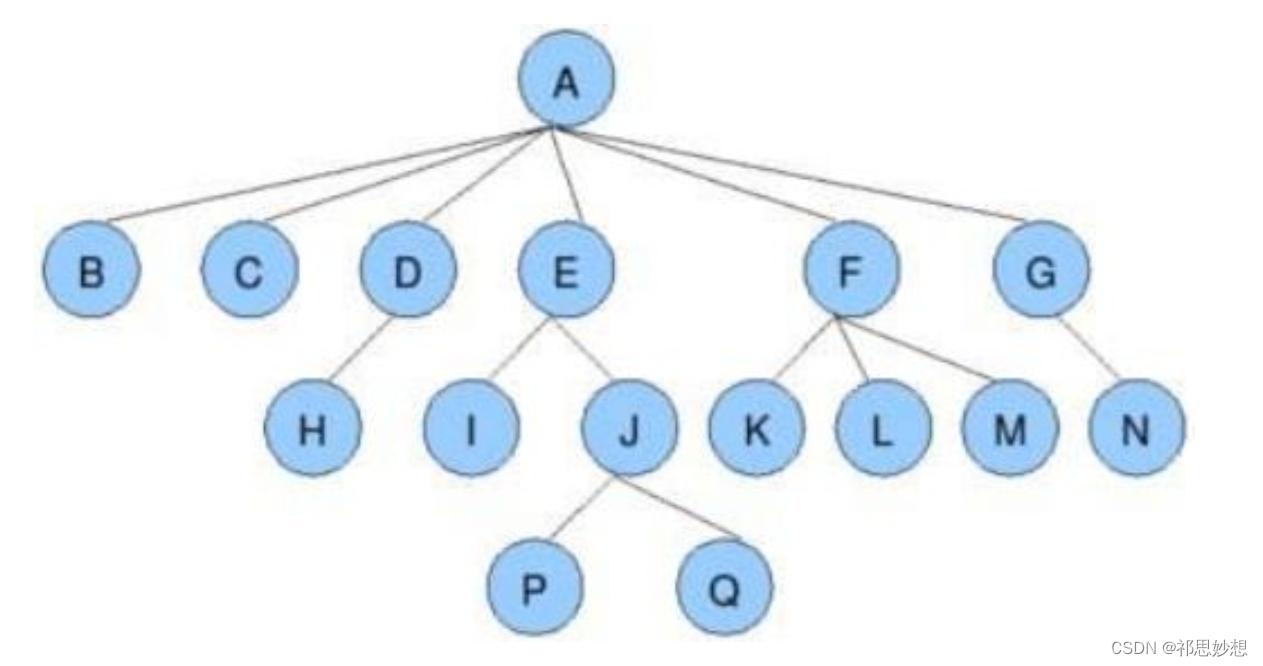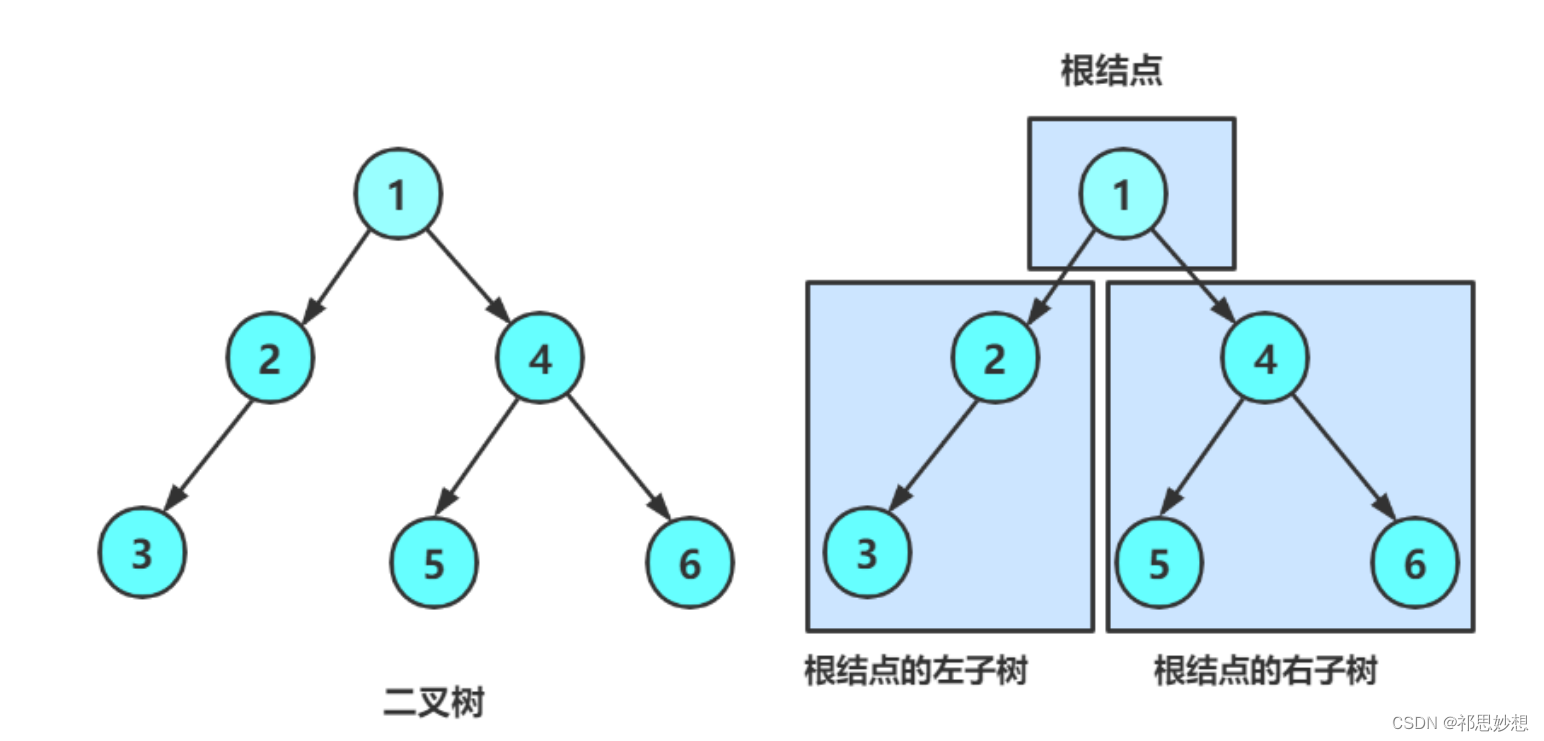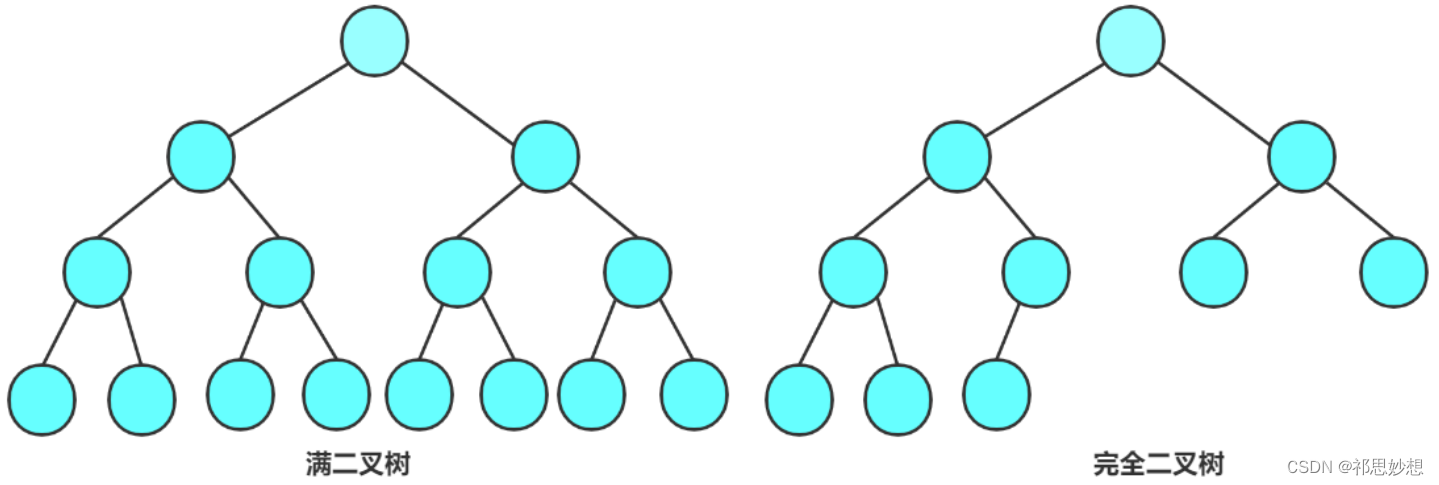前言
大家好,我目前在学习java。之前也学了一段时间,但是没有发布博客。时间过的真的很快。我会利用好这个暑假,来复习之前学过的内容,并整理好之前写过的博客进行发布。如果博客中有错误或者没有读懂的地方。热烈欢迎大家在评论区进行讨论!!!
喜欢我文章的兄弟姐妹们可以点赞,收藏和评论我的文章。喜欢我的兄弟姐妹们以及也想复习一遍java知识的兄弟姐妹们可以关注我呦,我会持续更新滴,
望支持!!!!!!一起加油呀!!!!
语言只是工具,不能决定你好不好找工作,决定你好不好找工作的是你的能力!!!!!
学历本科及以上就够用了!!!!!!!!!!!!!!!!!!!!!!
【本节目标】
1.掌握树的基本概念
2.掌握二叉树概念及特性
3.掌握二叉树的基本操作
4.完成二叉树相关的面试题练习
一、树的概念
1.1基本概念
树是一种非线性的数据结构,它是由n(n>=0)个有限结点组成一个具有层次关系的集合。把它叫做树是因为它看起来像一棵倒挂的树。它是根朝上,而叶朝下的。
- 它具有以下的特点:
- 有一个特殊的结点,称为根结点,根结点没有前驱结点
- 除根结点外,其余结点被分成M(M > 0)个互不相交的集合T1、T2、…、Tm,其中每一个集合Ti (1 <= i <=m) 又是一棵与树类似的子树。每棵子树的根结点有且只有一个前驱,可以有0个或多个后继
- 树是递归定义的。
//注意:树形结构中,子树之间不能有交集,否则就不是树形结构
1.2内部(重要)概念
1.结点的度:一个结点含有子树的个数称为该结点的度; 如上图:A的度为6
2.树的度:一棵树中,所有结点度的最大值称为树的度; 如上图:树的度为6
3.叶子结点或终端结点:度为0的结点称为叶结点; 如上图:B、C、H、I…等节点为叶结点
4.双亲结点或父结点:若一个结点含有子结点,则这个结点称为其子结点的父结点; 如上图:A是B的父结点
5.孩子结点或子结点:一个结点含有的子树的根结点称为该结点的子结点; 如上图:B是A的孩子结点
6.根结点:一棵树中,没有双亲结点的结点;如上图:A
7.结点的层次:从根开始定义起,根为第1层,根的子结点为第2层,以此类推
8.树的高度或深度:树中结点的最大层次; 如上图:树的高度为4树的以下概念只需了解,在看书时只要知道是什么意思即可:
非终端结点或分支结点:度不为0的结点; 如上图:D、E、F、G…等节点为分支结点
兄弟结点:具有相同父结点的结点互称为兄弟结点; 如上图:B、C是兄弟结点
堂兄弟结点:双亲在同一层的结点互为堂兄弟;如上图:H、I互为兄弟结点
结点的祖先:从根到该结点所经分支上的所有结点;如上图:A是所有结点的祖先
子孙:以某结点为根的子树中任一结点都称为该结点的子孙。如上图:所有结点都是A的子孙
森林:由m(m>=0)棵互不相交的树组成的集合称为森林
1.3树的表示形式
双亲表示法,孩子表示法、孩子双亲表示法、孩子兄弟表示法等等。
最常用的:孩子兄弟表示法。
1.4树的应用
文件管理系统(目录和文件)
二、二叉树的概念
2.1概念
一棵二叉树是结点的一个有限集合,该集合:
- 或者为空
- 或者是由一个根节点加上两棵别称为左子树和右子树的二叉树组成。
二叉树特点:
1.二叉树不存在度大于2的结点
2.二叉树的子树有左右之分,次序不能颠倒,因此二叉树是有序树
注意:对于任意的二叉树都是由以下几种情况复合而成的:
2.2两种特殊的二叉树
- 满二叉树:一棵二叉树,如果每层的结点数都达到最大值,则这棵二叉树就是满二叉树。也就是说,如果一棵二叉树的层数为K,且结点总数是,则它就是满二叉树。
- 完全二叉树:完全二叉树是效率很高的数据结构,完全二叉树是由满二叉树而引出来的。对于深度为K的,有n个结点的二叉树,当且仅当其每一个结点都与深度为K的满二叉树中编号从0至n-1的结点一一对应时称之为完全二叉树。
注意:满二叉树是一种特殊的完全二叉树。
2.3二叉树的性质
- 若规定根结点的层数为1,则一棵非空二叉树的第i层上最多有(i>0)个结点
- 若规定只有根结点的二叉树的深度为1,则深度为K的二叉树的最大结点数是(k>=0)
- 对任何一棵二叉树,如果其叶结点个数为n0,度为2的非叶结点个数为n2,则有n0=n2+1
- .具有n个结点的完全二叉树的深度k为log以2为低(n+1)上取整
- 对于具有n个结点的完全二叉树,如果按照从上至下从左至右的顺序对所有节点从0开始编号,则对于序号为i的结点有:
- 若i>0,双亲序号:(i-1)/2;i=0,i为根结点编号,无双亲结点
- 若2i+1<n,左孩子序号:2i+1,否则无左孩子
- 若2i+2<n,右孩子序号:2i+2,否则无右孩子
优先级队列
性质3的推导
节点:n = n1 + n2 + n3
边:e = 2n2 + n1 = n-1 (除根节点外每个节点对应一条边)
得出 2n2 + n1 = n1 + n2 + n3 -1
化简:n0= n2+ 1
2.4二叉树的存储
二叉树的存储结构分为:顺序存储和类似于链表的链式存储。
顺序存储在优先级队列文章介绍。
二叉树的链式存储是通过一个一个的节点引用起来的,常见的表示方式有二叉和三叉表示方式,具体如下:
// 孩子表示法
class Node {
int val; // 数据域
Node left; // 左孩子的引用,常常代表左孩子为根的整棵左子树
Node right; // 右孩子的引用,常常代表右孩子为根的整棵右子树
} /
/ 孩子双亲表示法
class Node {
int val; // 数据域
Node left; // 左孩子的引用,常常代表左孩子为根的整棵左子树
Node right; // 右孩子的引用,常常代表右孩子为根的整棵右子树
Node parent; // 当前节点的根节点
}
孩子双亲表示法后序在平衡树位置介绍,本文采用孩子表示法来构建二叉树。
三、二叉树的基本操作
// 前序遍历
void preOrder(Node root);
// 中序遍历
void inOrder(Node root);
// 后序遍历
void postOrder(Node root);
// 获取树中节点的个数
int size(Node root);
// 获取叶子节点的个数
int getLeafNodeCount(Node root);
// 子问题思路-求叶子结点个数
// 获取第K层节点的个数
int getKLevelNodeCount(Node root,int k);
// 获取二叉树的高度
int getHeight(Node root);
// 检测值为value的元素是否存在
Node find(Node root, int val);
//层序遍历
void levelOrder(Node root);
// 判断一棵树是不是完全二叉树
boolean isCompleteTree(Node root);
1.前序遍历
1.1 二叉树无返回值的前序遍历
//二叉树无返回值的前序遍历
public void prevOrder(TreeNode root){
if(root == null){
return;
}
System.out.print(root.val+" ");
preOrder(root.left);
preOrder(root.right);
}
1.2 二叉树有返回值的前序遍历
public List<Character> preorderTraversal(TreeNode root) {
List<Character> ret = new ArrayList<>();
if(root == null){
return ret;
}
ret.add(root.val);
List<Character> leftTree = preorderTraversal(root.left);
ret.addAll(leftTree);
List<Character> rightTree = preorderTraversal(root.right);
ret.addAll(rightTree);
return ret;
}
2.中序遍历
public void inOrder(TreeNode root){
if (root == null){
return;
}
inOrder(root.left);
System.out.print(root.val+" ");
inOrder(root.right);
}
public List<Character> inOrderTraversal(TreeNode root){
List<Character> ret = new ArrayList<>();
if(root == null){
return ret;
}
List<Character> leftTree = inOrderTraversal(root.left);
ret.addAll(leftTree);
ret.add(root.val);
List<Character> rightTree = inOrderTraversal(root.right);
ret.addAll(rightTree);
return ret;
}
3.后序遍历
//后序遍历
public void postOrder(TreeNode root){
if (root == null){
return;
}
postOrder(root.left);
postOrder(root.right);
System.out.print(root.val+" ");
}
public List<Character> postOrderTraversal(TreeNode root){
List<Character> ret = new ArrayList<>();
if(root == null){
return ret;
}
List<Character> leftTree = inOrderTraversal(root.left);
ret.addAll(leftTree);
List<Character> rightTree = inOrderTraversal(root.right);
ret.addAll(rightTree);
ret.add(root.val);
return ret;
}
4.获取树中节点个数
// 获取树中节点的个数
public int size;
int sizeNode(TreeNode root){
if(root == null){
return 0;
}
size++;
sizeNode(root.left);
sizeNode(root.right);
return size;
}
int sizeNode2(TreeNode root){
if(root == null){
return 0;
}
return sizeNode2(root.left)+sizeNode2(root.right)+1;
}
5.获取叶子节点的个数
//5. 获取叶子节点的个数(左右都为空)
int getLeafNodeCount1(TreeNode root){
if(root == null){
return 0;
}
if(root.left == null && root.right == null){
return 1;
}
return getLeafNodeCount1(root.left)+getLeafNodeCount1(root.right);
}
public int leafSize;
void getLeafNodeCount2(TreeNode root){
if(root == null){
return;
}
if(root.left == null && root.right == null){
leafSize++;
}
getLeafNodeCount2(root.left);
getLeafNodeCount2(root.right);
}
子问题思路-求叶子结点个数
// 子问题思路-求叶子结点个数
int getLeafNodeCount1(TreeNode root){
if(root == null){
return 0;
}
if(root.left == null && root.right == null){
return 1;
}
return getLeafNodeCount1(root.left)+getLeafNodeCount1(root.right);
}
//统计求解
public int leafSize;
void getLeafNodeCount2(TreeNode root){
if(root == null){
return;
}
if(root.left == null && root.right == null){
leafSize++;
}
getLeafNodeCount2(root.left);
getLeafNodeCount2(root.right);
}
6.获取第K层节点的个数
// 获取第K层节点的个数
int getKLevelNodeCount(TreeNode root,int k){
if(root == null){
return 0;
}
if(k == 1){
return 1;
}
return getKLevelNodeCount(root.left,k-1)+getKLevelNodeCount(root.right,k-1);
}
7.获取二叉树的高度
// 获取二叉树的高度
int getHeight(TreeNode root){
if(root ==null){
return 0;
}
getHeight(root.left);
getHeight(root.right);
return Math.max(getHeight(root.left),getHeight(root.right))+1;
}
int getHeight1(TreeNode root){
if(root ==null){
return 0;
}
int left = getHeight(root.left);
int right = getHeight(root.right);
return Math.max(left,right)+1;
}
int getHeight2(TreeNode root){
if(root ==null){
return 0;
}
return Math.max(getHeight(root.left),getHeight(root.right))+1;
}
8.检测值为value的元素是否存在
// 检测值为value的元素是否存在
boolean findVal(TreeNode root, int val){
if(root == null){
return false;
}
if(root.val == val){
return true;
}
boolean leftVal = findVal(root.left,val);
if(leftVal){
return true;
}
boolean rightVal = findVal(root.right,val);
if(rightVal){
return true;
}
return false;
}
9.层序遍历
//层序遍历(无返回值)
public void levelOrder(TreeNode root){
if(root == null){
return;
}
Queue<TreeNode> queue = new LinkedList<>();
queue.offer(root);
while (!queue.isEmpty()){
TreeNode cur = queue.poll();
System.out.print(cur.val+" ");
if(cur.left!=null){
queue.offer(cur.left);
}
if(cur.right!=null){
queue.offer(cur.right);
}
}
}
//有返回值为List<List<TreeNode>>的层序遍历
public List<List<TreeNode>> levelOrder2(TreeNode root){
List<List<TreeNode>> ret = new ArrayList<>();
if(root == null){
return ret;
}
Queue<TreeNode> queue = new LinkedList<>();
queue.offer(root);
while (!queue.isEmpty()){
int size = queue.size();
List<TreeNode> temp = new ArrayList<>();
while ((size!=0)){
TreeNode cur = queue.poll();
temp.add(cur);
size--;
if(cur.left!=null){
queue.offer(cur.left);
}
if(cur.right!=null){
queue.offer(cur.right);
}
}
ret.add(temp);
}
return ret;
}
//有返回值为List<List<Character>>的层序遍历
public List<List<Character>> levelOrder3(TreeNode root) {
List<List<Character>> ret = new ArrayList<>();
if(root == null){
return ret;
}
Queue<TreeNode> queue = new LinkedList<>();
queue.offer(root);
while (!queue.isEmpty()){
int size = queue.size();
List<Character> temp = new ArrayList<>();
while ((size!=0)){
TreeNode cur = queue.poll();
temp.add(cur.val);
size--;
if(cur.left!=null){
queue.offer(cur.left);
}
if(cur.right!=null){
queue.offer(cur.right);
}
}
ret.add(temp);
}
return ret;
}
10.判断一棵树是不是完全二叉树
public boolean isCompleteTree(TreeNode root){
if(root == null){
return true;
}
Queue<TreeNode> queue = new LinkedList<>();
queue.offer(root);
while (!queue.isEmpty()){
TreeNode cur = queue.poll();
if(cur != null){
queue.offer(cur.left);
queue.offer(cur.right);
}
else {//说明此时队列里全是空
break;
}
}
while (!queue.isEmpty()){
TreeNode cur = queue.poll();
if (cur != null){
return false;
}
}
return true;
}
1.首先如果这棵树为null,那么是完全二叉树返回true。
11.寻找节点路径问题
private boolean getPath(TreeNode root,TreeNode node,Stack<TreeNode> stack ){
if(root == null || node == null){
return false;
}
stack.push(root);
if(root == node){
return true;
}
boolean flg = getPath(root.left,node,stack);
if(flg == true){
return true;
}
boolean flg2 = getPath(root.right,node,stack);
if(flg2 == true){
return true;
}
stack.pop();
return false;
}
这个思想很简单。
1.如果树为null或节点为null那么没有找到路径,返回false。
2.接着将根节点添加到栈中。如果根节点为要找的节点。那么返回true。
3.接着去树的左边找,右边找。将每次路过的节点都添加到栈中。
4.如果左右两边都没有要找的节点。那么就弹出这个“根节点”。
5.最终栈留下来的就是我们要找的节点的路径了。返回true。
四、面试题练习
/**
* Definition for a binary tree node.
* public class TreeNode {
* int val;
* TreeNode left;
* TreeNode right;
* TreeNode() {}
* TreeNode(int val) { this.val = val; }
* TreeNode(int val, TreeNode left, TreeNode right) {
* this.val = val;
* this.left = left;
* this.right = right;
* }
* }
*/
class Solution {
public boolean isSameTree(TreeNode p, TreeNode q) {
if(p == null && q == null){
return true;
}
if(p != null && q == null || p == null && q != null){
return false;
}
if(p.val != q.val){
return false;
}
return isSameTree(p.left,q.left)&&isSameTree(p.right,q.right);
}
}
/**
* Definition for a binary tree node.
* public class TreeNode {
* int val;
* TreeNode left;
* TreeNode right;
* TreeNode() {}
* TreeNode(int val) { this.val = val; }
* TreeNode(int val, TreeNode left, TreeNode right) {
* this.val = val;
* this.left = left;
* this.right = right;
* }
* }
*/
class Solution {
public boolean isSubtree(TreeNode root, TreeNode subRoot) {
if(root == null){
return false;//容易漏掉
}
if(isSameTree(root,subRoot)){
return true;
}
if(isSubtree(root.left,subRoot)){
return true;
}
if(isSubtree(root.right,subRoot)){
return true;
}
return false;
}
public boolean isSameTree(TreeNode p, TreeNode q) {
if(p == null && q == null){
return true;
}
if(p != null && q == null || p == null && q != null){
return false;
}
if(p.val != q.val){
return false;
}
return isSameTree(p.left,q.left)&&isSameTree(p.right,q.right);
}
}
/**
* Definition for a binary tree node.
* public class TreeNode {
* int val;
* TreeNode left;
* TreeNode right;
* TreeNode() {}
* TreeNode(int val) { this.val = val; }
* TreeNode(int val, TreeNode left, TreeNode right) {
* this.val = val;
* this.left = left;
* this.right = right;
* }
* }
*/
class Solution {
public TreeNode invertTree(TreeNode root) {
if(root == null){
return null;
}
TreeNode temp = root.left;
root.left = root.right;
root.right = temp;
invertTree(root.left);
invertTree(root.right);
return root;
}
}
class Solution {
public boolean isBalanced(TreeNode root) {
if(root == null){
return true;
}
return biTreeHight(root)>=0;
}
public int biTreeHight(TreeNode root){
if(root == null){
return 0;
}
int hl = biTreeHight(root.left);
int hr = biTreeHight(root.right);
if(Math.abs(hl-hr)<=1&&hl>=0&&hr>=0){
return Math.max(hl,hr)+1;
}else{
return -1;
}
}
}
class Solution {
public boolean isSymmetric(TreeNode root) {
if(root == null){
return true;
}
return isSymmetricChild(root.left,root.right);
}
public boolean isSymmetricChild(TreeNode p,TreeNode q){
if(p == null && q == null){
return true;
}
if(p != null && q == null ||p == null && q != null){
return false;
}
if(p.val != q.val){
return false;
}
return isSymmetricChild(p.left,q.right)&& isSymmetricChild(p.right,q.left);
}
}
import java.util.Scanner;
class TreeNode{
char val;
TreeNode left;
TreeNode right;
public TreeNode(char val){
this.val = val;
}
}
// 注意类名必须为 Main, 不要有任何 package xxx 信息
public class Main {
public static void main(String[] args) {
Scanner in = new Scanner(System.in);
// 注意 hasNext 和 hasNextLine 的区别
while (in.hasNextLine()) { // 注意 while 处理多个 case
String str = in.nextLine();
TreeNode root = createTree(str);
inOrder(root);
}
}
public static int i = 0;
public static TreeNode createTree(String str){
TreeNode root = null;
if(str.charAt(i) != '#'){
root = new TreeNode(str.charAt(i));
i++;
root.left = createTree(str);
root.right = createTree(str);
}else{
i++;
}
return root;
}
public static void inOrder(TreeNode root){
if(root == null){
return;
}
inOrder(root.left);
System.out.print(root.val+" ");
inOrder(root.right);
}
}
class Solution {
public List<List<Integer>> levelOrder(TreeNode root) {
List<List<Integer>> ret = new ArrayList<>();
if(root == null){
return ret;
}
Queue<TreeNode> queue = new LinkedList<>();
queue.offer(root);
while (!queue.isEmpty()){
int size = queue.size();
List<Integer> temp = new ArrayList<>();
while ((size!=0)){
TreeNode cur = queue.poll();
temp.add(cur.val);
size--;
if(cur.left!=null){
queue.offer(cur.left);
}
if(cur.right!=null){
queue.offer(cur.right);
}
}
ret.add(temp);
}
return ret;
}
}
class Solution {
public TreeNode lowestCommonAncestor(TreeNode root, TreeNode p, TreeNode q) {
if(root == null){
return null;
}
Stack<TreeNode> stackP = new Stack<>();
Stack<TreeNode> stackQ = new Stack<>();
getPath(root,p,stackP);
getPath(root,q,stackQ);
int sizeP = stackP.size();
int sizeQ = stackQ.size();
if(sizeP>sizeQ){
int size = sizeP-sizeQ;
while(size != 0){
stackP.pop();
size--;
}
}else{
int size = sizeQ-sizeP;
while(size != 0){
stackQ.pop();
size--;
}
}
while(!stackP.isEmpty() && !stackQ.isEmpty()){
if(stackP.peek().equals(stackQ.peek())){
return stackP.peek();
}
stackP.pop();
stackQ.pop();
}
return null;
}
private boolean getPath(TreeNode root,TreeNode node,Stack<TreeNode> stack ){
if(root == null || node == null){
return false;
}
stack.push(root);
if(root == node){
return true;
}
boolean flg = getPath(root.left,node,stack);
if(flg == true){
return true;
}
boolean flg2 = getPath(root.right,node,stack);
if(flg2 == true){
return true;
}
stack.pop();
return false;
}
}
//利用递归
class Solution {
public TreeNode lowestCommonAncestor(TreeNode root, TreeNode p, TreeNode q) {
if(root == null){
return null;
}
if(p == root || q == root){
return root;
}
TreeNode leftTree = lowestCommonAncestor(root.left,p,q);
TreeNode rightTree = lowestCommonAncestor(root.right,p,q);
if(leftTree!= null && rightTree != null){
return root;
}else if(leftTree!=null){
return leftTree;
}else{
return rightTree;
}
}
}
class Solution {
public int preIndex;//成员变量
public TreeNode buildTree(int[] preorder, int[] inorder) {
return buildTreeChild(preorder,inorder,0,inorder.length-1);
}
private TreeNode buildTreeChild(int[] preorder,int[] inorder,int inbegin,int inend){
//1.若没有左树或者没有右树
if(inbegin>inend){
return null;
}
//2.创建根节点
TreeNode root = new TreeNode(preorder[preIndex]);
//3.从中序遍历中找到根节点下标
int rootIndex = findIndex(inorder,inbegin,inend,preorder[preIndex]);
if(rootIndex == -1){
return null;
}
preIndex++;
//4.先创建左子树 后创建右子树
root.left = buildTreeChild(preorder,inorder,inbegin,rootIndex-1);
root.right = buildTreeChild(preorder,inorder,rootIndex+1,inend);
return root;
}
private int findIndex(int[] inorder,int inbegin,int inend,int key){
for(int i = inbegin; i<= inend ; i++){
if(inorder[i] == key){
return i;
}
}
return -1;
}
}
/**
* Definition for a binary tree node.
* public class TreeNode {
* int val;
* TreeNode left;
* TreeNode right;
* TreeNode() {}
* TreeNode(int val) { this.val = val; }
* TreeNode(int val, TreeNode left, TreeNode right) {
* this.val = val;
* this.left = left;
* this.right = right;
* }
* }
*/
class Solution {
public int postIndex;//成员变量
public TreeNode buildTree(int[] inorder,int[] postorder) {
postIndex = postorder.length-1;
return buildTreeChild(postorder,inorder,0,inorder.length-1);
}
private TreeNode buildTreeChild(int[] postorder,int[] inorder,int inbegin,int inend){
//1.若没有左树或者没有右树
if(inbegin>inend){
return null;
}
//2.创建根节点
TreeNode root = new TreeNode(postorder[postIndex]);
//3.从中序遍历中找到根节点下标
int rootIndex = findIndex(inorder,inbegin,inend,postorder[postIndex]);
if(rootIndex == -1){
return null;
}
postIndex--;
//4.先创建左子树 后创建右子树
root.right = buildTreeChild(postorder,inorder,rootIndex+1,inend);
root.left = buildTreeChild(postorder,inorder,inbegin,rootIndex-1);
return root;
}
private int findIndex(int[] inorder,int inbegin,int inend,int key){
for(int i = inbegin; i<= inend ; i++){
if(inorder[i] == key){
return i;
}
}
return -1;
}
}
class Solution {
public String tree2str(TreeNode root) {
if (root == null) {
return "";
}
if (root.left == null && root.right == null) {
return Integer.toString(root.val);
}
if (root.right == null) {
return new StringBuffer().append(root.val).append("(").append(tree2str(root.left)).append(")").toString();
}
return new StringBuffer().append(root.val).append("(").append(tree2str(root.left)).append(")(").append(tree2str(root.right)).append(")").toString();
}
}
/**
* Definition for a binary tree node.
* public class TreeNode {
* int val;
* TreeNode left;
* TreeNode right;
* TreeNode() {}
* TreeNode(int val) { this.val = val; }
* TreeNode(int val, TreeNode left, TreeNode right) {
* this.val = val;
* this.left = left;
* this.right = right;
* }
* }
*/
class Solution {
public List<Integer> preorderTraversal(TreeNode root) {
List<Integer> ret = new ArrayList<>();
if(root == null){
return ret;
}
ret.add(root.val);
List<Integer> leftTree = preorderTraversal(root.left);
ret.addAll(leftTree);
List<Integer> rightTree = preorderTraversal(root.right);
ret.addAll(rightTree);
return ret;
}
}
class Solution {
public List<Integer> inorderTraversal(TreeNode root) {
List<Integer> ret = new ArrayList<>();
if(root == null){
return ret;
}
List<Integer> leftTree = inorderTraversal(root.left);
ret.addAll(leftTree);
ret.add(root.val);
List<Integer> rightTree = inorderTraversal(root.right);
ret.addAll(rightTree);
return ret;
}
}
/**
* Definition for a binary tree node.
* public class TreeNode {
* int val;
* TreeNode left;
* TreeNode right;
* TreeNode() {}
* TreeNode(int val) { this.val = val; }
* TreeNode(int val, TreeNode left, TreeNode right) {
* this.val = val;
* this.left = left;
* this.right = right;
* }
* }
*/
class Solution {
public List<Integer> postorderTraversal(TreeNode root) {
List<Integer> ret = new ArrayList<>();
if(root == null){
return ret;
}
List<Integer> leftTree = postorderTraversal(root.left);
ret.addAll(leftTree);
List<Integer> rightTree = postorderTraversal(root.right);
ret.addAll(rightTree);
ret.add(root.val);
return ret;
}
}



